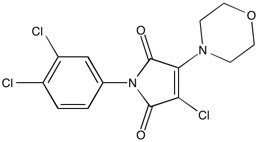RI-1 | RAD51 inhibitor
NMR (Conforms)

Available Options
| Size : | Price | Quantity | |
|---|---|---|---|
| 5 mg | $52.00 | ||
| 25 mg | $208.00 |
RI-1 (415713-60-9) is a potent and selective inhibitor of RAD51 (IC50 = 5-30 μM), a highly conserved protein that catalyzes DNA repair via homologous recombination.1 It specifically reduces gene conversion in human cells and stimulates single strand annealing. It covalently binds to Cys319 on the surface of RAD51 and disrupts protein-protein interaction. It potentiates the effect of DNA-damaging agents on tumor cells and is a novel tool for studying DNA repair in cells.2 Potentiates the killing of glioblastoma cells by ionizing radiation3 and alkylating drugs4.
References/Citations
1) Anand et al. (2017), Rad51-mediated double-strand break repair and mismatch correction of divergent substrates; Nature, 544 377
2) Budke et al. (2012), RI-1: a chemical inhibitor of RAD51 that disrupts homologous recombination in human cells; Nucleic Acids Res., 40 7347
3) Balbous et al. (2016), A radiosensitizing effect of RAD51 inhibition in glioblastoma stem-like cells; BMC Cancer, 16 604
4) Berte et al. (2016), Targeting Homologous Recombination by Pharmacological Inhibitors Enhances the Killing response of Glioblastoma Cells Treated with Alkylating Drugs; Mol. Cancer Ther., 15 2665
NMR (Conforms)
Safety Data Sheet:
Product Data Sheet:
Materials provided by Focus Biomolecules are for laboratory research use only and are not intended for human or veterinary applications. Please note that we do not sell to individuals and that all orders placed by non-research organizations will incur a $20 restocking/refund fee
RI-1 (415713-60-9) is a potent and selective inhibitor of RAD51 (IC50 = 5-30 μM), a highly conserved protein that catalyzes DNA repair via homologous recombination.1 It specifically reduces gene conversion in human cells and stimulates single strand annealing. It covalently binds to Cys319 on the surface of RAD51 and disrupts protein-protein interaction. It potentiates the effect of DNA-damaging agents on tumor cells and is a novel tool for studying DNA repair in cells.2 Potentiates the killing of glioblastoma cells by ionizing radiation3 and alkylating drugs4.
References/Citations
1) Anand et al. (2017), Rad51-mediated double-strand break repair and mismatch correction of divergent substrates; Nature, 544 377
2) Budke et al. (2012), RI-1: a chemical inhibitor of RAD51 that disrupts homologous recombination in human cells; Nucleic Acids Res., 40 7347
3) Balbous et al. (2016), A radiosensitizing effect of RAD51 inhibition in glioblastoma stem-like cells; BMC Cancer, 16 604
4) Berte et al. (2016), Targeting Homologous Recombination by Pharmacological Inhibitors Enhances the Killing response of Glioblastoma Cells Treated with Alkylating Drugs; Mol. Cancer Ther., 15 2665
Calculate the molar concentration, mass or volume in a solution.
Concentration × Volume × Molecular Weight = Mass
Focus Biomolecules • Plymouth Meeting, PA USA • 1-855-FOCUS21
Focus Biomolecules
Plymouth Meeting, PA USA
1-855-FOCUS21
Website Created by Advanta Advertising LLC.

